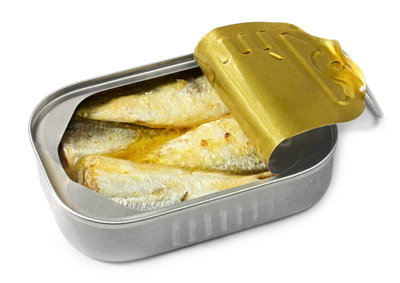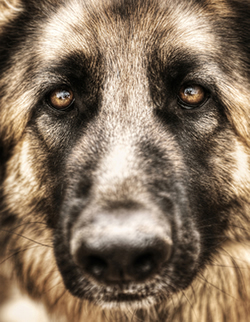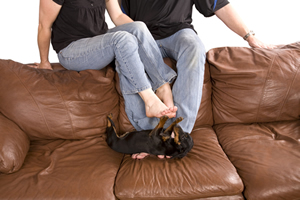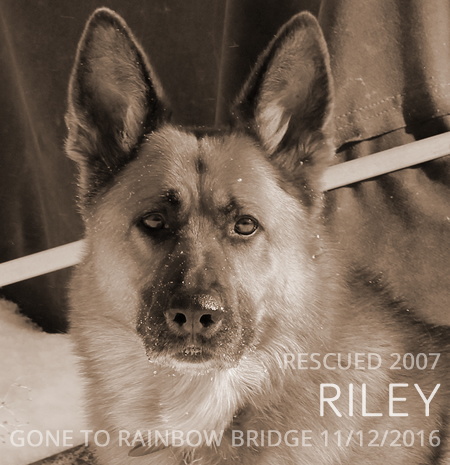Puppy with a Foot Fetish

Fish FUR BRAINS
February 10, 2013
I am a FOREVER dog
May 8, 2013I recently received an inquiry from a reader named Rachael regarding her new puppy who seems to have a foot fetish that I’d like to share with you. I will say the visual I got when reading Rachael’s story first gave me a case of the giggles, but once the giggles subsided I also realized that this pups behavior does need to be addressed. I’ll start with sharing Rachael’s story:
“Hi, very recently we got a new puppy and I’ve come across a few problems. My first problem is growling. My puppy loves to try and bite my feet, and when she does I often try and tell her off with a stern “no” and hold her collar to try and keep control of her. However a lot of the time she will growl and bark at me and eventually I have to move her away to stop her behaviour. How can I fix this? Sometimes she will listen, she is only 8 weeks and responds well to her name and the command sit allready, but I can’t seem to stop her growling and barking. Pleas reply, I’ve been doing a lot of research and could really do with your help. Thanks, Rachael”
Hi, very recently we got a new puppy and I’ve come across a few problems. My first problem is growling. My puppy loves to try and bite my feet, and when she does I often try and tell her off with a stern “no” and hold her collar to try and keep control of her. However a lot of the time she will growl and bark at me and eventually I have to move her away to stop her behaviour. How can I fix this? Sometimes she will listen, she is only 8 weeks and responds well to her name and the command sit allready, but I can’t seem to stop her growling and barking. Pleas reply, I’ve been doing a lot of research and could really do with your help. Thanks, Rachael
First of all, thanks for writing, Rachael. I hope you’ll find some help in our response.
The first thing I took into consideration is that this is a puppy and puppies do things like this. I really don’t think your pup’s behavior is abnormal at all. On the other hand, I have no doubt it’s annoying and sometimes painful (ouch! puppy teeth!) and if not stopped could turn into a continuing problem so you are absolutely right in hunting down a behavior adjustment for her.
It’s a Game to Your Pup
It sounds to me like your pup considers this to be a game and your feet are toys. She’s too young at this point to understand what “no” means as a whole and this is something you’re already working on teaching her.
I would suggest that you change your method, though. When you grab a dog’s collar you’re restraining them, which in most cases just makes a dog want more of whatever they’re being restrained from. You’re defeating yourself by grabbing her collar and so my first suggestion is to ditch the collar grabbing thing. I would save collar grabbing of any sort for emergencies only, for example any danger to your pup from an outside source or from your pup to an outside source.
If your voice has any kind of excitement in it when you tell her no, you’re also escalating her behavior because she hears only the tone of your voice and feels your excitement. People tend to sound angry or irritated when they use the word “no” as well. To a dog that can also be a form of excitement so remember that any kind of excitement in your voice can escalate any behavior your dog is practicing at that moment. Keeping your voice firm but more of a monotone will probably be more successful.
Sit Wins the Game
An alternative method would be at the instant she starts to play the game, you stand up, plant your feet firmly on the floor/ground and don’t move. In a calm firm (but not angry) voice, use her name and then your sit command. The moment she begins to sit, treat her with that yummy treat from your pocket and praise her for sitting. Unless she’s already sitting immediately on command, you may have to do this in progressive steps getting her butt near the floor a bit more each time before you treat. Each time she starts the game follow through with the same scenario but wait just that split second longer for her to get her butt on the floor in a sit. The timing of all of this is important because you want her to know that she’s being treated and praised for sitting which in turn gets her to leave your feet alone. In effect what you’re doing here is trading your feet for a treat which is the same principal as taking something away from your dog that you don’t want them to have (your child’s favorite stuff toy for example) and giving them something they can have.
Taking this a step further, as soon as you’ve gotten the sit, forked over the treat and you’re in praise mode you can start walking away. You may need to continue a bit of positive reinforcement if she takes aim at your feet when you start walking. You’ll first need to repeat what you just did by stopping and getting that sit following through to the praise before you move again. You can also try at least one of two things with the potential for more alternatives depending on how creative you are. #1 would be to hold another treat in your over her head area as you walk which should keep her attention on the treat or #2 you could toss a ball or other favorite toy a few feet so she’ll avert her attention to chasing the toy.
Growling and Barking
The growling and barking might take a bit more time and effort. Being that a dog doesn’t come pre-programmed in the human language and the dictionary definitions of our words, a dog needs to be taught what “quiet” means. When you’re working on getting that sit at your feet from her, she may or may not stop barking so you may have to add “quiet time” to the mix. In other words, treat her when she stops the barking and growling. Do not treat her during the sit process unless she stops the noise behavior first. Your standing up may or may not also stop the noise. By doing this, you’re interrupting her concentration which is what you want to do. One of the arts in dog training is to treat at the precise second your dog does what you want them to do so timing is crucial. Wait her out, the second she stops the noise, treat her using the command “quiet.” Remember, the tone of your voice should have an effect on her voice. Stand there quietly, looking her in the face but be silent about it. (See the “Exception to the Rule” section just below.) My guess is she’ll look up at you and if you’re silent, no matter how much noise she makes she will likely stop barking and growling.
An Exception to the “Never Stare a Dog in the Face or Eyes” Rule
I don’t normally recommend staring a dog in the face because it can be dangerous, but this is a puppy and it’s your puppy so you should be able to get away with staring her in the eyes. Staring her down may also help teach her that just because she’s being stared at, doesn’t necessarily mean there’s an eminent threat or that she’s being confronted which is a good thing for our dogs to learn. Conditioning her to being accepting of direct eye contact may help keep people safe from any potential confrontational behavior on her part.
A good way to incorporate this into your dog training is to read up on and practice the “Watch Me” command which you should be able to find in Google visit. Better yet, if you’re not already doing so, take her to obedience classes with a professional dog trainer. To my knowledge the “Watch Me” command is part of every early obedience class. It’s strongly recommended in the dog world that anyone with a new pup or new-to-you dog in the home attend obedience classes. There are many benefits to this including helping you build a strong bond between you and your dog.
Safety Reminder: NEVER EVER stare a strange dog in the face or eyes! Direct eye contact can be dangerous!
Hopefully, these methods will work better for you than what you’re doing now. Good luck and let us know how it goes!
Anyone else have any suggestions for Rachael?



4 Comments
After two days I’m seeing some improvements. I’ve learnt that if I am calm and stand tall it makes a suprisingly big difference. My puppy is learning to sit and wait after a bad behaviour and she has learnt to expect a treat, praise or a game when she does. Thanks again and keep up the good work.
That’s great news, Rachael! Keep us posted, ok?
The method is working well thanks, she still bites of course but we are making progress. I’ve even taught my younger cousins who are visiting for a few weeks to use that method for when she is behaving badly. Now she sits straight after corrections! It’s working great! I’m also working on teaching her to wait at the door and she’s leanring quickly, but we are having troubles with her prey drive towards the cat and chooks. any advice? thanks
Thank you so much!!!